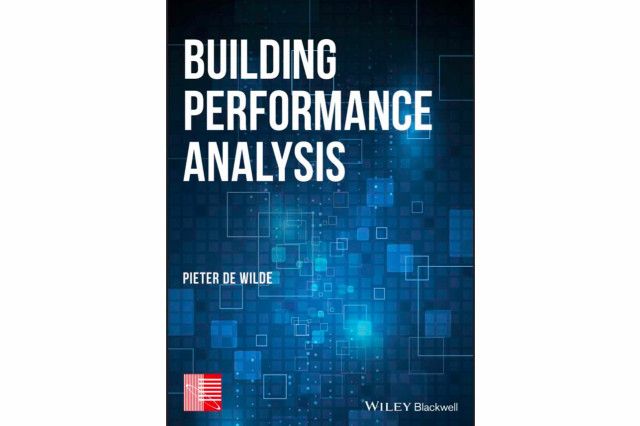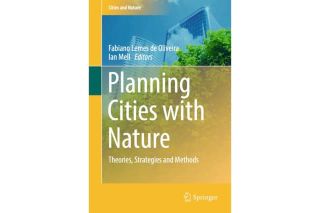
www.buildingsandcities.org/insights/reviews/building-performance-analysis-review.html
Building Performance Analysis

By Pieter de Wilde. Wiley Blackwell, 2018, ISBN: 9781119341925.
Michael Donn (Victoria University of Wellington) reviews this book which provides an account of the context for building performance analysis and various techniques for undertaking this.
The International Building Performance Simulation Association (IBPSA) entry for Pieter de Wilde lists him as "an expert in the use of building simulation in the building design, services and engineering community." Professor de Wilde's book 'Building Performance Analysis' contains an endorsement from IBPSA which states "…the book mobilises an extensive quantity of relevant literature on this broad subject, making it an invaluable resource for students at all levels. Each chapter concludes with a list of activities that not only serves as a summary of the material covered but also provides an excellent basis from which to develop student projects and assessments."
To this reader, the joy and delight of this book is this extensive literature. It led me, for example, to a secondary reference to a Progressive Architecture (PA) special issue on 'Performance Design'. The editorial in this extensive 45 page discussion of the potential of Operations Research in architectural design addresses 'Architectural schizophrenia': where Performance Design (i.e., design based on reason and reality, …) might create a dilemma for the architect-as-artist used to a "more intuitive and less rational approach". The focus of this special issue on a Systems Engineering approach to examining the connection between building design and performance, foreshadows the approach taken in this book which, for example, quotes the System Engineering Body of Knowledge 45 times.
I will confess, I found the book a tough read. It reads like an extended annotated bibliography. It is therefore rich in references, but the text does not flow readily. However, the more I read, the more I came to understand and appreciate the quality of the analysis. Like all the best analyses of the literature, this one develops themes and presents a bigger picture than the individual pieces. For example, Chapter 3 from a bold proposition that "building performance as a concept … expresses how well a building performs a task or function", develops its Systems Engineering view using many clear examples into a set of performance attributes that fit under the "engineering, process and aesthetic views of performance". Immediately, one is struck that this last view is a remit that might resolve the PA editor's concern about architects simultaneously trying to be a part of civilisation and to subvert it.
The tri-partite views of performance seem
almost like an attempt to emulate Vitruvius's commodity, firmness and delight functions of
buildings. And raise the usual questions about why only three, and where can
one fit common attributes of buildings like connectivity in planning, or the
health effects of material or environmental choices? But this is a well-argued,
and deeply referenced Systems Engineering case for including a wide range of
building attributes in performance evaluation.
Unexpectedly for a book entitled Building Performance Analysis, especially one
endorsed by IBPSA, much of this book is focused on the context and application
of the concept of building performance, not on the tools by which it might be
assessed. This is valuable. Examining the needs of building occupants and the type
of criteria by which performance might be assessed to support those needs makes
for far more interesting reading than lists of criteria. That said, where actual
criteria are mentioned, they are presented in a simplistic manner: it is
disappointing to read the eye has two types of "photosensitive cells", when the
lighting industry has been working on the retinal ganglion cells (RGC) for
close to two decades.
But, the value of the book is the big
picture: how can the ability to define performance criteria fit with the ability
to predict performance, and then weigh design decisions balancing several criteria?
This process and the various techniques and contexts in which decisions might
be made are canvassed broadly in the three major sections of the book: Foundation,
Assessment and Impact. The Foundation section provides an interesting insight
into the role of systems engineering in examining the users' needs and the
definition of performance in buildings. I found the categorisation of
performance requirements under four headings, particularly intriguing. In my
view, the future of Building Performance Analysis is assured, if we can develop
performance models able to address these four categories: "functional
requirements, performance requirements, design constraints and condition
constraints".
The Assessment section contains a useful
discussion of the application of "black
box", "grey box" and "white box" models that link known inputs to predicted
performance (outputs). The insights and
application domains of an analysis in this section of the nature of the models
in common use for performance analysis is promising. The black box is merely
use of known correlations between inputs and outputs, with no in-built
modelling of the building physics or human behaviour. White box models, by
contrast, explicitly model the relationship between inputs and outputs. The
description of the tools that can be
used in different building performance domains (air flow, acoustics, energy,
fire, lighting etc) is generally interesting. The list of actual software tools
is certainly a starting point for the graduate student looking to establish a
thesis starting point. However, not categorising these into the
black/white/grey typology is an opportunity missed, and mention of programs
like Ecotect and Energy-10 somewhat undermines the credibility because they have
not been available for general use for many years.
The third section of the book, Impact, really
has only two chapters developing the book's theme: first Design and
Construction, and then Operation and Control. The third chapter in this section
consists of a definition of a 'high performance building'. Apart from a useful
set of references as to the origin and definition of 'high performance', this does
not seem to develop the book's theme. The first two chapters, like most of the
rest in the book, summarise the literature on the types of building design and
operational analyses that are feasible,
not how these analyses might be performed. They do not provide direct
guidance. Apart from a comprehensive listing and general description of each analysis
activity, they do not offer any guidance on how
these activities might be developed in practice.
The final chapter of the book, after these
three sections, provides a bookend to match the ambition of the introduction.
It posits an 'emergent theory' of building performance analysis. In the absence
of a theory, a model of how the world works, research cannot design experiments
to test the theory. Emergent theories derive from a systematic analysis of information
gathered by survey or other means, such as the massive amount of reference
information contained in this book. They are typically intended to create a framework that can be subject
to systematic test. Creating experiments for these tests following a standard scientific methodology typically
requires an hypothesis to be tested. This chapter delivers a multitude of 'tentative'
hypotheses. Few, however, are testable. The strength of this chapter is not, in
my opinion, these hypotheses. Rather, it is the summary observations of an
author after he has compiled the mass of the preceding chapters' reference
material. He has distilled his observations into a 15 page series of
propositions having examined the literature though the lens of Systems
Engineering.
In summary then, would I recommend this book? Yes. I believe the author has achieved his objective expressed in the introduction to "… bring together the existent body of knowledge on building performance analysis". The core three sections of this book could form the basis of a Building Performance Analysis Body of Knowledge (BPABoK). They could readily be converted to an electronically accessible and updateable database. The Introduction contains sufficient definition material to form the background to a BPABoK. The "Epilogue" reads more like a manifesto that could be used over time to identify gaps in the BPABoK. Until such a body of knowledge becomes available, I suggest every budding Building Performance Analyst whether learning to model fire egress, daylight or carbon accounting needs to read the introduction. Too often the apprentice Simulationist focuses on how to use the tools, not why. This book provides that context.
Latest Peer-Reviewed Journal Content
Designing for pro-environmental behaviour change: the aspiration–reality gap
J Simpson & J Uttley
Lifetimes of demolished buildings in US and European cities
J Berglund-Brown, I Dobie, J Hewitt, C De Wolf & J Ochsendorf
Expanding the framework of urban living labs using grassroots methods
T Ahmed, I Delsante & L Migliavacca
Youth engagement in urban living labs: tools, methods and pedagogies
N Charalambous, C Panayi, C Mady, T Augustinčić & D Berc
Co-creating urban transformation: a stakeholder analysis for Germany’s heat transition
P Heger, C Bieber, M Hendawy & A Shooshtari
Placemaking living lab: creating resilient social and spatial infrastructures
M Dodd, N Madabhushi & R Lees
Church pipe organs: historical tuning records as indoor environmental evidence
B Bingley, A Knight & Y Xing
A framework for 1.5°C-aligned GHG budgets in architecture
G Betti, I Spaar, D Bachmann, A Jerosch-Herold, E Kühner, R Yang, K Avhad & S Sinning
Net zero retrofit of the building stock [editorial]
D Godoy-Shimizu & P Steadman
Co-learning in living labs: nurturing civic agency and resilience
A Belfield
The importance of multi-roles and code-switching in living labs
H Noller & A Tarik
Researchers’ shifting roles in living labs for knowledge co-production
C-C Dobre & G Faldi
Increasing civic resilience in urban living labs: city authorities’ roles
E Alatalo, M Laine & M Kyrönviita
Co-curation as civic practice in community engagement
Z Li, M Sunikka-Blank, R Purohit & F Samuel
Preserving buildings: emission reductions from circular economy strategies in Austria
N Alaux, V Kulmer, J Vogel & A Passer
Urban living labs: relationality between institutions and local circularity
P Palo, M Adelfio, J Lundin & E Brandão
Living labs: epistemic modelling, temporariness and land value
J Clossick, T Khonsari & U Steven
Co-creating interventions to prevent mosquito-borne disease transmission in hospitals
O Sloan Wood, E Lupenza, D M Agnello, J B Knudsen, M Msellem, K L Schiøler & F Saleh
Circularity at the neighbourhood scale: co-creative living lab lessons
J Honsa, A Versele, T Van de Kerckhove & C Piccardo
Positive energy districts and energy communities: how living labs create value
E Malakhatka, O Shafqat, A Sandoff & L Thuvander
Built environment governance and professionalism: the end of laissez-faire (again)
S Foxell
Co-creating justice in housing energy transitions through energy living labs
D Ricci, C Leiwakabessy, S van Wieringen, P de Koning & T Konstantinou
HVAC characterisation of existing Canadian buildings for decarbonisation retrofit identification
J Adebisi & J J McArthur
Simulation and the building performance gap [editorial]
M Donn
Developing criteria for effective building-sector commitments in nationally determined contributions
P Graham, K McFarlane & M Taheri
Join Our Community

The most important part of any journal is our people – readers, authors, reviewers, editorial board members and editors. You are cordially invited to join our community by joining our mailing list. We send out occasional emails about the journal – calls for papers, special issues, events and more.
We will not share your email with third parties. Read more



Latest Commentaries
COP30 Report
Matti Kuittinen (Aalto University) reflects on his experience of attending the 2025 UN Conference of the Parties in Belém, Brazil. The roadmaps and commitments failed to deliver the objectives of the 2025 Paris Agreement. However, 2 countries - Japan and Senegal - announced they are creating roadmaps to decarbonise their buildings. An international group of government ministers put housing on the agenda - specifying the need for reduced carbon and energy use along with affordability, quality and climate resilience.
Building-Related Research: New Context, New Challenges
Raymond J. Cole (University of British Columbia) reflects on the key challenges raised in the 34 commissioned essays for Buildings & Cities 5th anniversary. Not only are key research issues identified, but the consequences of changing contexts for conducting research and tailoring its influence on society are highlighted as key areas of action.